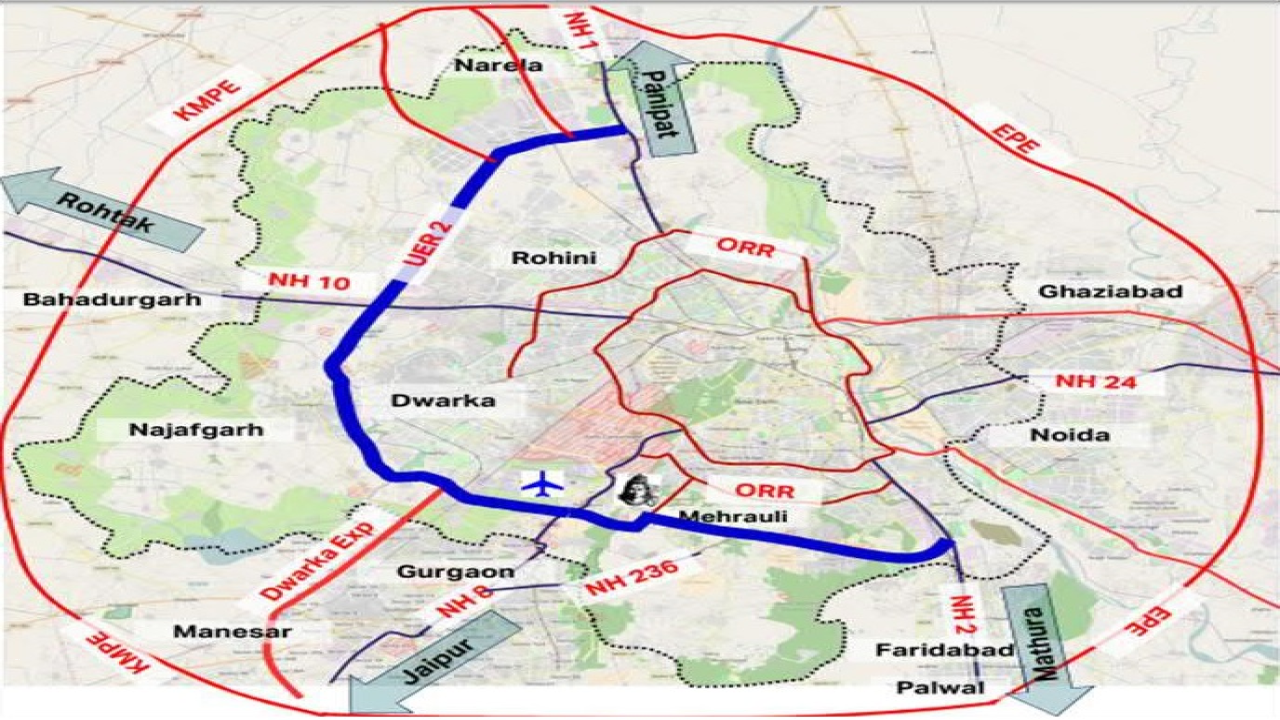Urban Extension Road-2 Project (UER-II)
The National Capital Territory of Delhi is one of the most congested cities in India. The city attracts a huge quantum of traffic not only from within Delhi but also from the surrounding regions of Haryana and Uttar Pradesh. This high level of traffic has led to heavy congestion on the existing ring roads. To address this issue and save Delhi through decongestion, the Delhi Development Authority (DDA) proposed Urban Extension Road-2 (UER-II) as the third ring road of Delhi.
What is UER-II?
The UER-II has been proposed in the Delhi Master Plan as the third Ring Road of Delhi along the Western boundary. The six-lane access-controlled highway is being developed by the National Highways Authority of India (NHAI) as a component of the Delhi Decongestion Plan, at a capital cost of Rs 7716 crore. The UER-II will connect NH-1 to Dwarka and Bahadurgarh and form a Ring Road along the western range.
The alignment of UER-II
The total length of UER-II is 46.5 km, out of which 38.11 km is taken up as part of this project, and a part alignment is being taken up with the alignment of the Dwarka Expressway. The UER-II’s alignment takes off from NH 1 (23.8 km) near village Bankoli and terminates near the junction of Sector 24 in Dwarka. The route will connect NH-1 with NH-8 passing through Bawana Industrial Area, Rohini, Mundka Industrial Area, Najafgarh, and Dwarka.
The current status of the project
Tenders for construction were invited by NHAI in December 2019, and construction contracts were awarded in 2021. So far, 57 per cent of work is complete: 55 per cent on Package 1, 40 per cent on Package 2, 90 per cent on Package 3, 68 per cent on Package 4 and 67 per cent on Package 5. While the NHAI had set a deadline of October 2023, Union Minister for Road Transport and Highways Nitin Gadkari has promised to open the key arterial road by December 2023 after inspecting the progress of the Urban Extension Road Project (UER-II) in Delhi.
Why is the UER-II critical to decongesting Delhi?
The UER-II is expected to serve as a key solution for decongesting Delhi, providing an alternative route for non-Delhi destined traffic i.e. traffic to/from North Indian states (Punjab, Northern Haryana, J&K, Himachal Pradesh) to remaining Indian states (Rajasthan, Southern Haryana, Gujarat, Maharashtra) which currently passes through Delhi. The completion of the UER-II will reduce the load on the existing ring roads and help to reduce traffic congestion in Delhi.
The unique features of the UER-II
The UER-II has several unique features that make it stand out. First, the road has been constructed using almost 20 lakh tonnes of plastic garbage sourced from Ghazipur landfill in Delhi. The waste is processed at micro plants near the construction site in Alipur and Karala. Second, the UER-II has 27 flyovers, 26 minor bridges, 11 underpasses, and 17 pedestrian subways. Lastly, it will also be among the first national highways to be an e-highway. E-highways are an energy-efficient option where the road provides electricity to moving vehicles mostly through overhead power lines.
Month: Current Affairs - March, 2023
Category: India Nation & States Current Affairs






